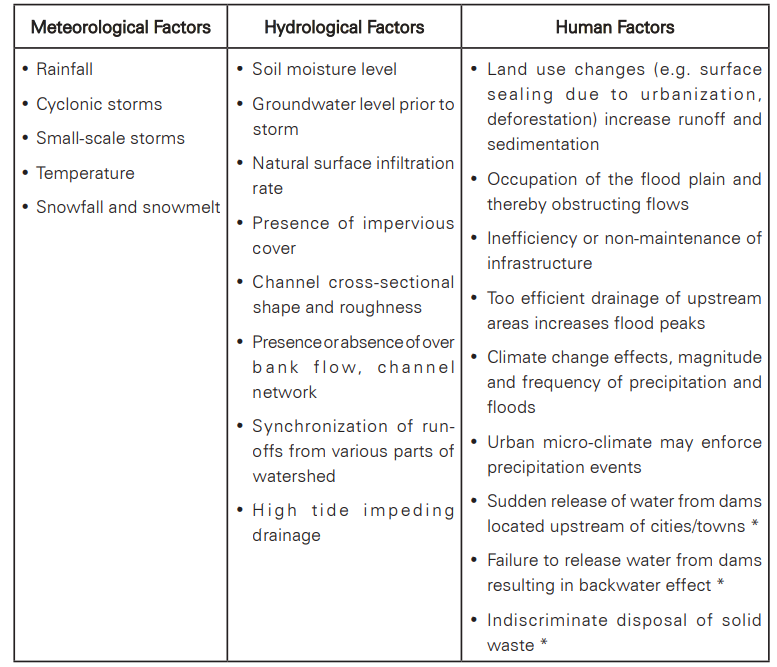-
29 Jul 2022
GS Paper 3
Disaster Management
Day 19: Discuss the factors responsible for the occurrence of frequent floods and its effects on life and economy. In the light of guidelines of NDMA (2008) describe the mechanisms for preparedness to reduce the risk during such events. (250 words)
- Briefly define flood and types of floods and state some incidents of floods in recent.
- Write the factors responsible for the occurrence of frequent floods and its effects on life and economy.
- Mention the important mechanisms for preparedness to reduce the risk with reference to the guidelines of NDMA.
- Conclude suitably.
Answer
A flood is an overflow of water that submerges land that is usually dry. There are three common types of floods: Flash floods are caused by rapid and extensive rainfall; river floods are caused when consistent rain or snow melt forces a river to exceed capacity; coastal floods are caused by storm surges associated with tropical cyclones and tsunami. Every year, India has experienced devasting floods affecting millions of people. Examples: Assam floods, Odisha floods, Uttarakhand floods, Mumbai floods etc.
Impact of floods
Floods killed 109,412 people last 65 years (1952-2018). Over 258 million hectares of crops were damaged and 81,187,187 houses were raged. The total economic losses due to crops, houses and other property damage came to Rs 4.69 trillion. India suffered a loss of Rs 95,736 crore in 2018 floods.
- Loss of lives and property: Immediate impacts of flooding include loss of human life, damage to property, destruction of crops, loss of livestock, non-functioning of infrastructure facilities and deterioration of health condition owing to waterborne diseases.
- Loss of livelihoods: As communication links and infrastructure such as power plants, roads and bridges are damaged and disrupted, economic activities come to a standstill, resulting in dislocation and the dysfunction of normal life for a period
- Decreased purchasing and production power: Damage to infrastructure also causes long-term impacts, such as disruptions of clean water and electricity supply, transport, communication, education and health care.
- Mass migration: Frequent flooding, resulting in loss of livelihoods, production and other prolonged economic impacts and types of suffering can trigger mass migration or population displacement. Migration to developed urban areas contributes to the overcrowding in the cities.
- Psychosocial effects: The huge psycho-social effects on flood victims and their families can traumatize them for long periods of time. The loss of loved ones can generate deep impacts, especially on children. Displacement from one’s home, loss of property, loss of memorablia and livelihoods, decreased levels of security in the aftermath of floods and in temporary shelters, and disruption to business and social affairs can cause stress.
- Hindering economic growth and development: The high cost of relief and recovery may adversely impact investment in infrastructure and other development activities in the area and in certain cases may cripple the frail economy of the region. Recurrent flooding in a region may discourage long-term investments by the government and private sector alike.
- Political implications: Ineffective flood response and relief operations during major flood events regularly lead to public discontent or loss of trust in the authorities or the state and national governments.
Guidelines of NDMA to reduce the risk during such events
Structural measures:
- Embankments/Banks, Flood Walls, Flood Levees: The embankment system in the river restricts the river to its existing course and prevents it from overflowing the banks. Embankments are constructed generally with earth easily available from nearby areas.
- Dams, Reservoirs and other Water Storages: Lakes, low lying depressions, tanks, dams and reservoirs store significant proportions of flood water and the stored water can be released subsequently when the flood has receded.
- Channel Improvement: A channel can be made to carry flood discharge at levels lower than its prevailing high flood level by improving its discharge carrying capacity.
- Desilting/Dredging of Rivers: Selective desilting/dredging at outfalls/confluences or local reaches can, however, be adopted as a measure to tackle the problem locally.
- Drainage Improvement: Surface water drainage congestion due to inadequacy of natural or manmade drainage channels results in flooding in many areas. In such cases constructing new channels and/or improving the capacity of existing channels constitute an effective means of flood control.
- Catchment Area Treatment/Afforestation: Watershed management measures such as afforestation and conservation of soil cover in conjunction with structural works like check dams, detention basins etc. serve as an effective measure in reducing flood peaks and controlling the suddenness of the runoff.
Non-Structural Measures:
- Flood Plain Zoning
- Flood Proofing
- Flood Forecasting and Warning
As floods cause major damage to life and property every year, it is time the central and the state governments prepare a long-term plan that goes beyond piecemeal measures like building embankments and dredging to control floods. Also, there is a need for an integrated basin management plan that brings all the river-basin sharing countries as well Indian states on board.






